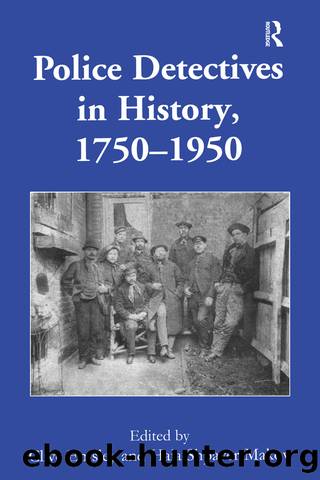Police Detectives in History, 1750â1950 by Clive Emsley Haia Shpayer-Makov

Author:Clive Emsley, Haia Shpayer-Makov [Clive Emsley, Haia Shpayer-Makov]
Language: eng
Format: epub
Tags: Nonfiction, History
ISBN: 9781351910576
Publisher: Taylor and Francis
Published: 2017-09-29T04:00:00+00:00
Investigating crime is a hard and exacting task, demanding a man's every energy and making him a not unwilling slave of his job. There are no such things as fixed hours or regular mealtimes for a detective; and while engaged on a case his home-life practically ceases to exist. His assignment must come before everything else.92
Conceivably, the silence of the memoirists about their family life was meant to suggest their total and undivided dedication to their work.
Night work, in particular, entailed a variety of hardships, including the difficulty to stay awake and harsh weather. Describing an unforgettable night time incident, John Littlechild recalls that his blood froze when he frightened a flock of hundreds of sparrows who made a rushing noise that filled him with terror.93 Such descriptions were a far cry from the comfortable life led by many fictional detectives. They conveyed hard physical tasks akin to the toil of manual workers. Yet, the message emanating from the memoirists' discourse is that the methods they used, even if not based principally on pure reasoning or encyclopaedic knowledge of the individual investigator, were in no way less efficient or effective than the fictitious ones attributed to detectives in novels and stories.
Assimilated into these descriptions of hard work were revelations about the risks involved. Lansdowne pointed out that 'an account of the life of a police detective would be incomplete without some reference to the dangers of death which beset the calling, and which every detective in the service must be prepared to run'.94 In a similar fashion, Berrett commented that 'officers took big risks in those days. Not infrequent were the attempts made to injure, even indeed, to murder them'.95 Some criminals operated alone and others were organised in dangerous gangs. According to Detective Sergeant Benjamin Leeson, the criminals involved in the Sidney Street siege in January 1911 were not 'the ordinary burglar type', but a 'sinister organisation which was causing me and my colleagues so many sleepless nights'.96 Leeson, who was wounded during the siege, had to be discharged from service as a result and live 'on a sum much below the wages of a constable'.97
The memoirs of Special Branch officers, in particular, are replete with incidents involving dangerous Fenians, nihilists, anarchists and Bolsheviks, which heightened the sense of danger under which detectives operated but at the same time glamorised their work,98 The first task of the Special Branch, when it was established in the early 1880s, was to fight the rising tide of Fenian terrorism. Littlechild 'shudder[ed] to think of the consequences if these emissaries had been successful in all their operations', as 'the public does not realise the peril in which it was placed'.99 He used the opportunity to make the point that 'evil-doers rarely give Scotland Yard credit for efficient policing'. Another public enemy - the anarchists - was depicted as no less ruthless. Of all the political refugees who found asylum in Britain, they were considered the most dangerous, 'an ever-present menace to the peace of Europe', in the words of Detective Inspector Harold Brust.
Download
This site does not store any files on its server. We only index and link to content provided by other sites. Please contact the content providers to delete copyright contents if any and email us, we'll remove relevant links or contents immediately.
Russia's Sakhalin Penal Colony, 1849â1917 by Andrew A. Gentes(176)
A History of Police and Masculinities, 1700-2010 by David G. Barrie Susan Broomhall(128)
Introduction to Criminal Justice - A Balanced Approach by Brian K. Payne Willard M. Oliver Nancy E. Marion(122)
Serial Killers America and UK - 2 BOOKS IN 1 by Clark Matthew(107)
Policing Gender, Class And Family In Britain, 1800-1945 by Linda Mahood(96)
Cops, Cameras, and Crisis by Michael D. White Aili Malm(90)
Restorative Justice in Transitional Settings by Kerry Clamp(88)
Dangerousness, Risk and the Governance of Serious Sexual and Violent Offenders by Karen Harrison(88)
Organized Crime and Corruption Across Borders by T. Wing Lo Dina Siegel Sharon I Kwok(85)
A Theory of African American Offending by James D. Unnever Shaun L. Gabbidon(81)
Losing Legitimacy by Gary Lafree(78)
The Real CSI by Kate Bendelow(76)
Routledge Handbook on Immigration and Crime by Holly Ventura Miller Anthony Peguero(73)
Forensic Criminology by Andy Williams(73)
The 1921 Tulsa Race Massacre by Chris M. Messer(73)
Women Exiting Prison by Bree Carlton Marie Segrave(72)
Broadmoor--My Journey Into Hell by Charlie Bronson(71)
Police Detectives in History, 1750â1950 by Clive Emsley Haia Shpayer-Makov(71)
Using Murder by Philip Jenkins(67)
